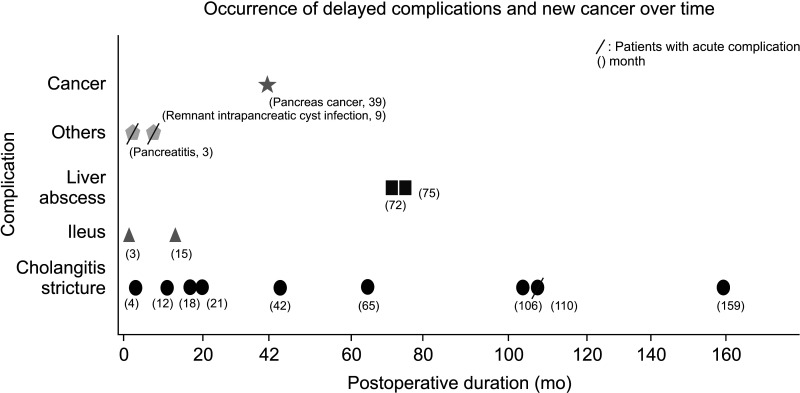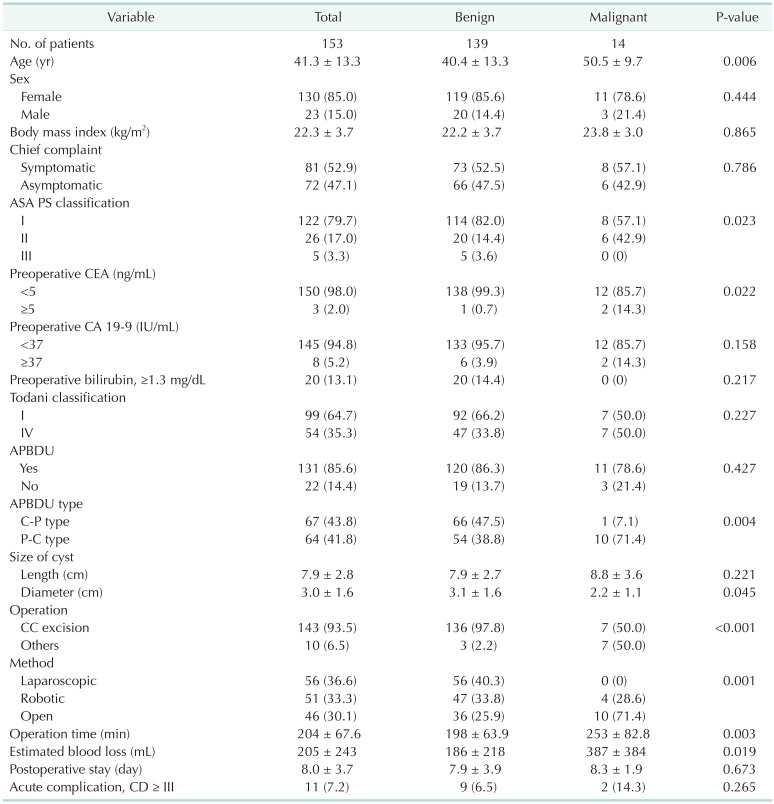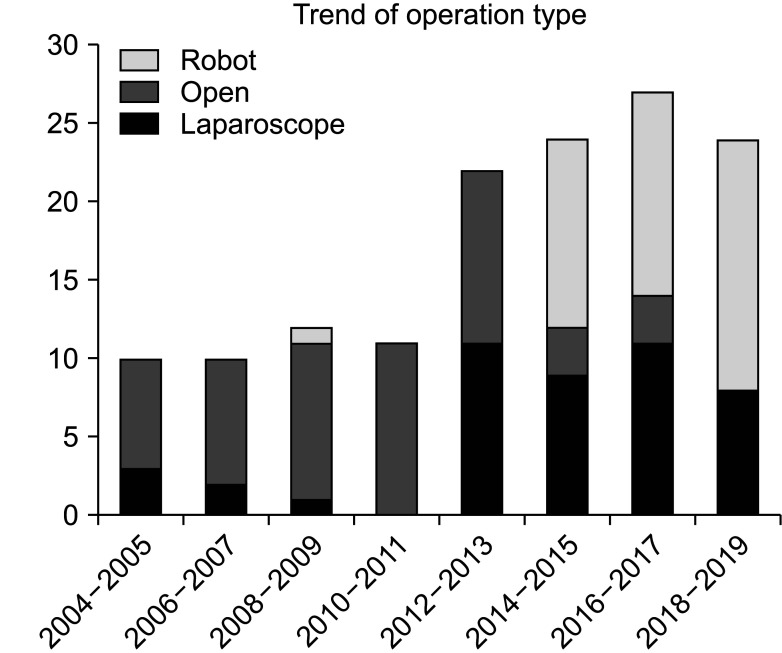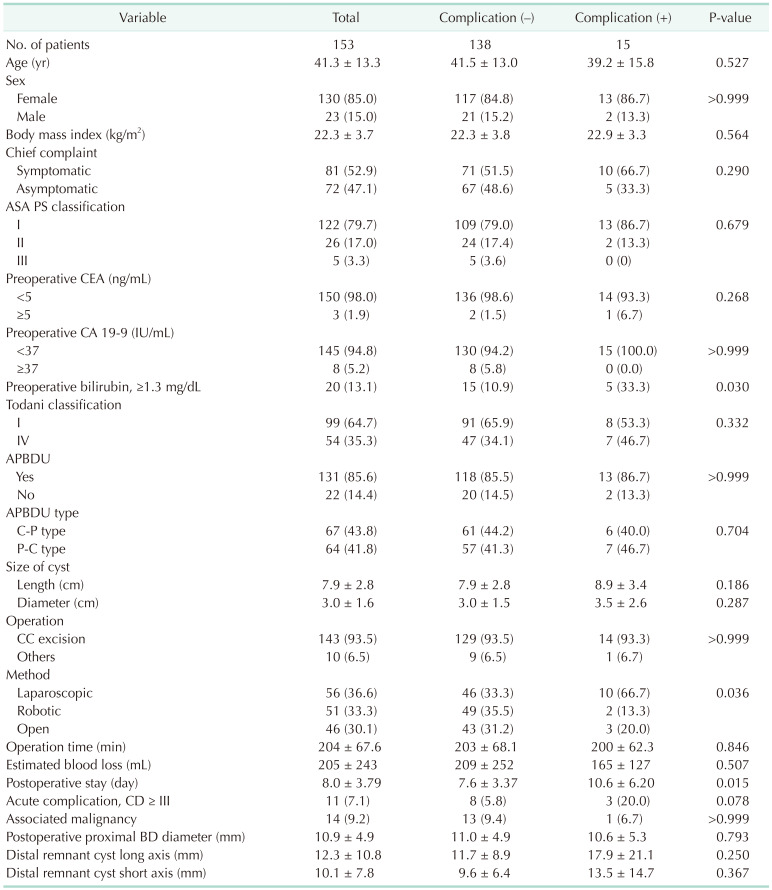1. Shah OJ, Shera AH, Zargar SA, Shah P, Robbani I, Dhar S, et al. Choledochal cysts in children and adults with contrasting profiles: 11-year experience at a tertiary care center in Kashmir. World J Surg. 2009; 33:2403–2411. PMID:
19701664.

2. Yamaguchi M. Congenital choledochal cyst: analysis of 1,433 patients in the Japanese literature. Am J Surg. 1980; 140:653–657. PMID:
6776832.
3. Kamisawa T, Ando H, Suyama M, Shimada M, Morine Y, Shimada H, et al. Japanese clinical practice guidelines for pancreaticobiliary maljunction. J Gastroenterol. 2012; 47:731–759. PMID:
22722902.

4. Edil BH, Cameron JL, Reddy S, Lum Y, Lipsett PA, Nathan H, et al. Choledochal cyst disease in children and adults: a 30-year single-institution experience. J Am Coll Surg. 2008; 206:1000–1008. PMID:
18471743.

5. Nagata E, Sakai K, Kinoshita H, Hirohashi K. Choledochal cyst: complications of anomalous connection between the choledochus and pancreatic duct and carcinoma of the biliary tract. World J Surg. 1986; 10:102–110. PMID:
3962321.

6. Jang SM, Lee BS, Kim KK, Lee JN, Koo YS, Kim YS, et al. Clinical comparison of choledochal cysts between children and adults. Korean J Hepatobiliary Pancreat Surg. 2011; 15:157–163. PMID:
26421033.

7. Lee SE, Jang JY, Lee YJ, Choi DW, Lee WJ, Cho BH, et al. Choledochal cyst and associated malignant tumors in adults: a multicenter survey in South Korea. Arch Surg. 2011; 146:1178–1184. PMID:
22006877.
8. Saito T, Terui K, Mitsunaga T, Nakata M, Yoshida H. Significance of imaging modalities for preoperative evaluation of the pancreaticobiliary system in surgery for pediatric choledochal cyst. J Hepatobiliary Pancreat Sci. 2016; 23:347–352. PMID:
26994400.

9. Jan YY, Chen HM, Chen MF. Malignancy in choledochal cysts. Hepatogastroenterology. 2000; 47:337–340. PMID:
10791183.
10. Nicholl M, Pitt HA, Wolf P, Cooney J, Kalayoglu M, Shilyansky J, et al. Choledochal cysts in western adults: complexities compared to children. J Gastrointest Surg. 2004; 8:245–252. PMID:
15019916.

11. Sastry AV, Abbadessa B, Wayne MG, Steele JG, Cooperman AM. What is the incidence of biliary carcinoma in choledochal cysts, when do they develop, and how should it affect management? World J Surg. 2015; 39:487–492. PMID:
25322698.

12. Ishibashi T, Kasahara K, Yasuda Y, Nagai H, Makino S, Kanazawa K. Malignant change in the biliary tract after excision of choledochal cyst. Br J Surg. 1997; 84:1687–1691. PMID:
9448616.

13. Ohashi T, Wakai T, Kubota M, Matsuda Y, Arai Y, Ohyama T, et al. Risk of subsequent biliary malignancy in patients undergoing cyst excision for congenital choledochal cysts. J Gastroenterol Hepatol. 2013; 28:243–247. PMID:
22989043.

14. Watanabe Y, Toki A, Todani T. Bile duct cancer developed after cyst excision for choledochal cyst. J Hepatobiliary Pancreat Surg. 1999; 6:207–212. PMID:
10526053.

15. Xie X, Li K, Wang J, Wang C, Xiang B. Comparison of pediatric choledochal cyst excisions with open procedures, laparoscopic procedures and robot-assisted procedures: a retrospective study. Surg Endosc. 2020; 34:3223–3231. PMID:
32347390.

16. Jang JY, Yoon YS, Kang MJ, Kwon W, Park JW, Chang YR, et al. Laparoscopic excision of a choledochal cyst in 82 consecutive patients. Surg Endosc. 2013; 27:1648–1652. PMID:
23239299.

17. Stringer MD. Laparoscopic management of choledochal cysts: is a keyhole view missing the big picture? Pediatr Surg Int. 2017; 33:651–655. PMID:
28424862.

18. Shen HJ, Xu M, Zhu HY, Yang C, Li F, Li KW, et al. Laparoscopic versus open surgery in children with choledochal cysts: a meta-analysis. Pediatr Surg Int. 2015; 31:529–534. PMID:
25895070.

19. Jung K, Han HS, Cho JY, Yoon YS, Hwang DW. Is preoperative subclassification of type I choledochal cyst necessary? Korean J Radiol. 2012; 13(Suppl 1):S112–S116. PMID:
22563281.

20. Lee KH, Tam YH, Yeung CK, Chan KW, Sihoe JD, Cheung ST, et al. Laparoscopic excision of choledochal cysts in children: an intermediate-term report. Pediatr Surg Int. 2009; 25:355–360. PMID:
19255762.

21. Cho MJ, Hwang S, Lee YJ, Kim KH, Ahn CS, Moon DB, et al. Surgical experience of 204 cases of adult choledochal cyst disease over 14 years. World J Surg. 2011; 35:1094–1102. PMID:
21360306.

22. Soares KC, Kim Y, Spolverato G, Maithel S, Bauer TW, Marques H, et al. Presentation and clinical outcomes of choledochal cysts in children and adults: a multi-institutional analysis. JAMA Surg. 2015; 150:577–584. PMID:
25923827.
23. Chang J, Jang JY, Kang MJ, Jung W, Shin YC, Kim SW. Clinicopathologic differences in patients with gallbladder cancer according to the presence of anomalous biliopancreatic junction. World J Surg. 2016; 40:1211–1217. PMID:
26630938.

24. Komi N, Takehara H, Kunitomo K, Miyoshi Y, Yagi T. Does the type of anomalous arrangement of pancreaticobiliary ducts influence the surgery and prognosis of choledochal cyst? J Pediatr Surg. 1992; 27:728–731. PMID:
1306647.

25. Tashiro S, Imaizumi T, Ohkawa H, Okada A, Katoh T, Kawaharada Y, et al. Pancreaticobiliary maljunction: retrospective and nationwide survey in Japan. J Hepatobiliary Pancreat Surg. 2003; 10:345–351. PMID:
14598134.

26. Lee H, Kwon W, Han Y, Kim JR, Kim SW, Jang JY. Comparison of surgical outcomes of intracorporeal hepaticojejunostomy in the excision of choledochal cysts using laparoscopic versus robot techniques. Ann Surg Treat Res. 2018; 94:190–195. PMID:
29629353.

27. Xie X, Li Y, Li K, Wang Q, Xiang B. Total robot-assisted choledochal cyst excision using da Vinci surgical system in pediatrics: report of 10 cases. J Pediatr Surg. 2021; 56:553–558. PMID:
32829883.






 PDF
PDF Citation
Citation Print
Print







 XML Download
XML Download